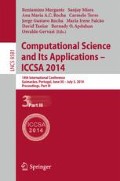Abstract
The goal of this paper is to present a multiobjective model to optimize the blend of virgin oils for biodiesel production, minimizing costs and life-cycle Greenhouse Gas (GHG) emissions. Prediction models for biodiesel properties based on the chemical composition of the oils were used to establish technical constraints of the model. Biodiesel produced in Portugal from palm, rapeseed and/or soya was used as a case study. The model was solved using the Ɛ-constraint method and the resulting Pareto curve reveals the trade-off between costs and GHG emissions, from which it was possible to calculate GHG abatement costs. Illustrative results are presented: GHG emissions (not accounting for direct and indirect Land Use Change -LUC) and biodiesel production costs (focused on oil feedstock). Analyzing the blends along the Pareto curve, a reduction in GHG emissions is obtained by progressively replacing rapeseed by soya and reducing the palm share in the blend used for biodiesel production.
Access this chapter
Tax calculation will be finalised at checkout
Purchases are for personal use only
Preview
Unable to display preview. Download preview PDF.
References
OECD-FAO: Agricultural Outlook 2011-2020 OECD/FAO (2011)
Refaat, A.A.: Correlation between the chemical structure of biodiesel and its physical properties. International Journal of Environmental Science & Technology 6(4), 677–694 (2009)
Gülsen, E., Olivetti, E., Freire, F., Dias, L., Kirchain, R.: Impact of feedstock diversification on the cost-effectiveness of biodiesel. Applied Energy 126(1), 281–296 (2014)
Hoekman, S.K., Broch, A., Robbins, C., Ceniceros, E., Natarajan, M.: Review of biodiesel composition, properties, and specifications. Renewable and Sustainable Energy Reviews 16(1), 143–169 (2012)
Giakoumis, E.G.: A statistical investigation of biodiesel physical and chemical properties, and their correlation with the degree of unsaturation. Renewable Energy 50, 858–878 (2013)
European Comission: Directive 2009/28/EC of the European Parliament and of the Council on the promotion of the use of energy from renewable sources, 16–62 (2009)
Fröhling, M., Rentz, O.: A case study on raw material blending for the recycling of ferrous wastes in a blast furnace. Journal of Cleaner Production 18(2), 161–173 (2010)
Li, X., Yu, H., Yuan, M.: Modeling and Optimization of Cement Raw Materials Blending Process. Mathematical Problems in Engineering 2012, 1–30 (2012)
Lingshuang, K., Chunhua, Y., Shenping, X., Gang, C.: Stochastic Optimization Method Based on HSS Technique and Expert Knowledge for a Metallurgical Blending Process. In: 2013 Third International Conference on Intelligent System Design and Engineering Applications, pp. 1290–1293 (2013)
European Committee for Standardization. EN 14214: automotive fuels – fatty acid methyl esters (FAME) for diesel engines – requirements and test methods.Report no. EN 14214:2008. Management Centre (2008)
Standard specification for biodiesel fuel blend stock (B100) for middle distillate fuels. Report no. D6751-08. ASTM (2008)
Bamgboye, A.I., Hansen, A.C.: Prediction of cetane number of biodiesel fuel from the fatty acid methyl ester (FAME) composition, 21–29 (2008)
Ramos, M.J., Fernández, C.M., Casas, A., Rodríguez, L., Pérez, A.: Influence of fatty acid composition of raw materials on biodiesel properties. Bioresource Technology 100(1), 261–268 (2009)
Park, J.-Y., Kim, D.-K., Lee, J.-P., Park, S.-C., Kim, Y.-J., Lee, J.-S.: Blending effects of biodiesels on oxidation stability and low temperature flow properties. Bioresource Technology 99(5), 1196–1203 (2008)
Castanheira, É.G., Acevedo, H., Freire, F.: Greenhouse gas intensity of palm oil produced in Colombia addressing alternative land use change and fertilization scenarios. Applied Energy 114, 958–967 (2014)
Castanheira, É.G., Freire, F.: Avaliação de Ciclo de Vida das emissões de Gases com Efeito de Estufa da Produção de Biodiesel de Soja em Portugal. Relatório Final elaborado para a APPB, no âmbito do Protocolo de colaboração entre a APPB e a ADAI. Coimbra (2011)
Malça, J., Coelho, A., Freire, F.: Environmental Life-Cycle Assessment of rapeseed-based biodiesel: alternative cultivation systems and locations. Applied Energy 114, 837–844 (2014)
Castanheira, É.G.: Environmental sustainability assessment of soybean and palm biodiesel systems: A life-cycle approach, University of Coimbra (2014)
Castanheira, É.G., Grisoli, R., Freire, F., Coelho, S.: Environmental sustainability of biodiesel in Brazil. Energy Policy 65, 680–691 (2014)
Index Mundi, http://www.indexmundi.com/
GAMS Development Corporation. General Algebraic Modeling System (GAMS) Release 23.7.3 Washington, DC, USA (2011)
Diekmann, J., Jochem, E.: Methodological Guideline for Assessing the Impact of Measures for Emission Mitigation, Jülich (1998)
UNEP: Mitigation and Adaptation Assessment. Concepts, Methods and Appropriate Use. UNEP Collaborating Centre on Energy and Environment, Roskilde, Denmark, p. 169 (1998)
Author information
Authors and Affiliations
Editor information
Editors and Affiliations
Rights and permissions
Copyright information
© 2014 Springer International Publishing Switzerland
About this paper
Cite this paper
Caldeira, C., Gülsen, E., Olivetti, E.A., Kirchain, R., Dias, L., Freire, F. (2014). A Multiobjective Model for Biodiesel Blends Minimizing Cost and Greenhouse Gas Emissions. In: Murgante, B., et al. Computational Science and Its Applications – ICCSA 2014. ICCSA 2014. Lecture Notes in Computer Science, vol 8581. Springer, Cham. https://doi.org/10.1007/978-3-319-09150-1_48
Download citation
DOI: https://doi.org/10.1007/978-3-319-09150-1_48
Publisher Name: Springer, Cham
Print ISBN: 978-3-319-09149-5
Online ISBN: 978-3-319-09150-1
eBook Packages: Computer ScienceComputer Science (R0)

